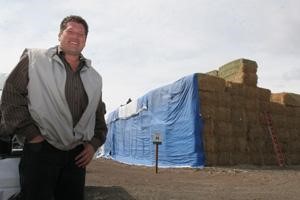Animal feed is the one item that needs to be stored well, or it spoils. Storing hay to maintain its quality can be done in several different ways; the main thing to remember is that you want it covered.
Tarps work and they’re cheap, but they aren’t a good long-term option. They tear, or blow away unless very well secured in the first place; and sunlight eventually rots them, so they only last a season or two.
One thing that can help is weighing tarps down well with old tires or blocks, or using tent stakes to tie them down. When using traps, don’t tightly enclose your whole pile of hay, or any moisture that is in the bales will cause them to rot in no time. Hay needs to have some air movement in and around the pile. Small hay piles benefit from being stacked on wooden pallets; this keeps soil moisture from ruining the bottom bales.
If you are dealing with large quantities of hay, a pole shed with just a roof, or a roof and one wall that blocks the predominant wind protects hay well yet lets the air move around it. These structures are also relatively inexpensive to build. Hoop houses are also good for hay storage. Hay that is being stored in any type of enclosed structure must be adequately dry, or it may start on fire. As the hay cures, it heats up, and sometimes it can heat up enough to spontaneously combust!
Livestock kept with grass-farming strategies don’t generally need grain in such large quantities that bulk storage space is necessary. The best way to store the small amounts of grain is in garbage cans or 55-gallon (208 l) drums. (Metal or plastic is fine, but make sure the drum contained food-grade materials before: You don’t want to poison your stock.)
As with hay, the grain must be well dried before it goes into storage. Dampness breeds mould (and possibly mycotoxins) and fire. Grain or premixed feeds that are being purchased from a reputable feed dealer should always be adequately dry, and most of the time area farmers whom you buy from directly won’t be selling you wet feed. But when you buy grain at harvest time, make sure the grain has been tested for moisture. Most feed stores can provide this service, or you can test your own sample.

Haystacks Covered with a Tarp
Click here to view a video that explains feed storage and handling.